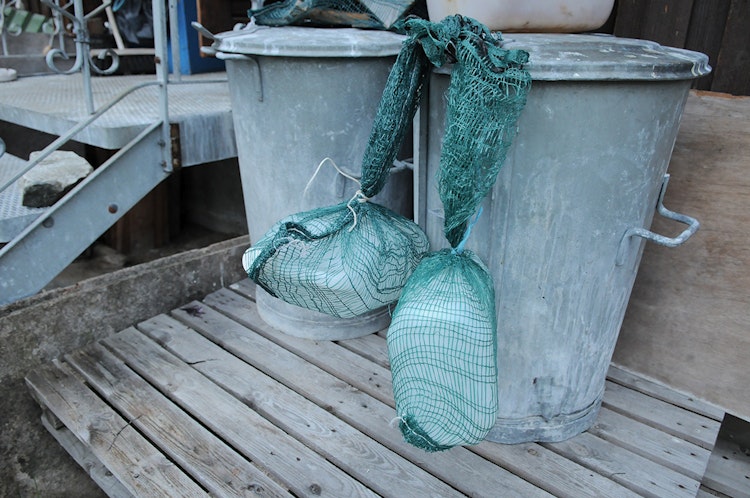

Namita Gupta Wiggers
courtesy of Joar Nango
In this conversation between curator, artist and educator Namita Gupta Wiggers and artist Joar Nango we are introduced to Joar Nango's work and methods, and how it incorporates material flow cycles, duodji and collaboration.
In September 2017, I had the privilege of visiting Tromsø, Norway, while a curator-in-residence with Norwegian Crafts. Thanks to André Gali and Lars Sture [Norwegian Crafts editor and curator, respectivly], we had numerous conversations with artists, curators, gallerists, and scholars, and ended our time with a visit to the studio of Joar Nango. As our visit came to an end, he mentioned an interest in a discussion of duodji and its connection to Norwegian craft at a future date. The following discussion is a composite of two conversations – one via skype in April 2018, and the initial discussion the previous Fall.
It was while traveling through Norway that the breadth of categories of craft and the way each linked to Norwegian cultures – but did not necessarily intersect directly with a seemingly separate realm of Sámi cultures - became a topic of conversation.1 Throughout the two conversations with Joar Nango, I found myself resistant to defining or trying to push him to define duodji in concrete and specific terms. It does not make sense to do so, and what follows, instead, is a conversation that pivots on topics connected to craft in all categories, to Sámi cultures specifically, and which raises questions about representation, ethno-symbolism and the colonial gaze, materials and material flow, process, and nomadism through Joar Nango’s individual thinking on duodji as part of the philosophy and cosmology through which he works.
The deep philosophy of duodji is really about a local material flow cycle
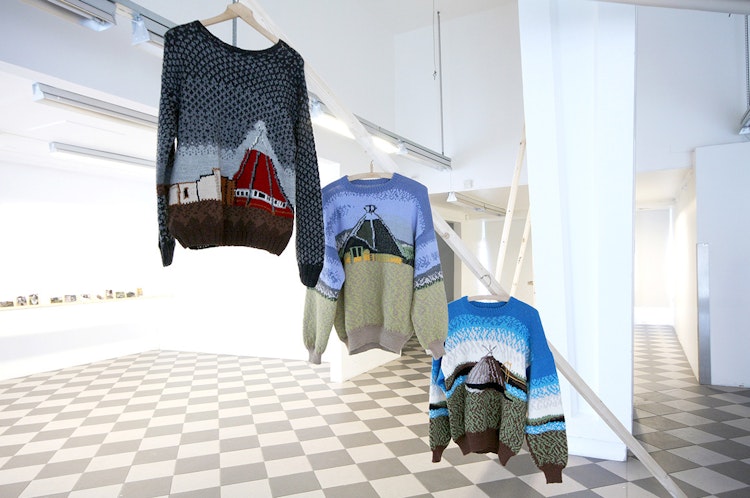
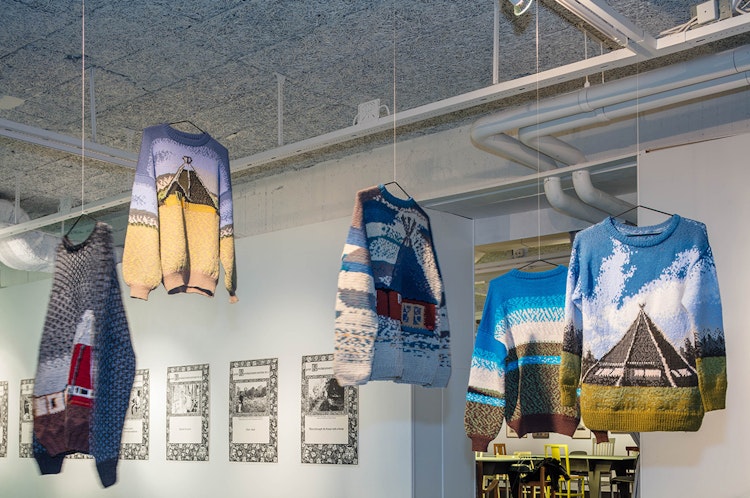
Let’s talk for a moment about the sweater project. Your studio wall in Tromsø is full of images of architecture from the Arctic north – some of which you’ve translated into clothing. What is the relationship between this architecture and handknit sweaters?
'There is this tendency of formal architecture where a plastic symbol from Sámi traditions is just blown up into a large sort of giant scale. The traditional Sámi tent – that's just sort of taken into otherwise quite conventional architecture and pulled over the head of that architecture. It becomes simplified in my point of view, a very simplified way of dealing with a cultural tradition. I wanted to somehow take the idea back to the very basics of architecture which is clothing, the first layer of shelter. I made some sweaters that were knitted in wool by women in these villages where these houses and buildings are using patterns designed by me and based on these series of photographs.'
It’s a humorous and complex project that visually engages the double bind of a colonial situation. You explained that this particular type of architecture that expanded since the 1960s, is not designed by Sámi architects, but is employed within Sámi environments. Located in such contexts, these buildings seem simultaneously problematic and reassuring in their presence.
'I felt like I was not really contributing so much by continuously criticizing it. I wanted to be on the creative end of discourse, not only to be negative but also embrace it in a way because actually, even if I see them as simplified and architecturally stupid, I think that many of them have had and still have a very important effect because they're symbols of our Sámi presence in a colonized environment. It's a signifier for local people. It's very important.'
I think it's interesting to maintain the philosophical concept that you find in duodji but rethink it in a more contemporary scale
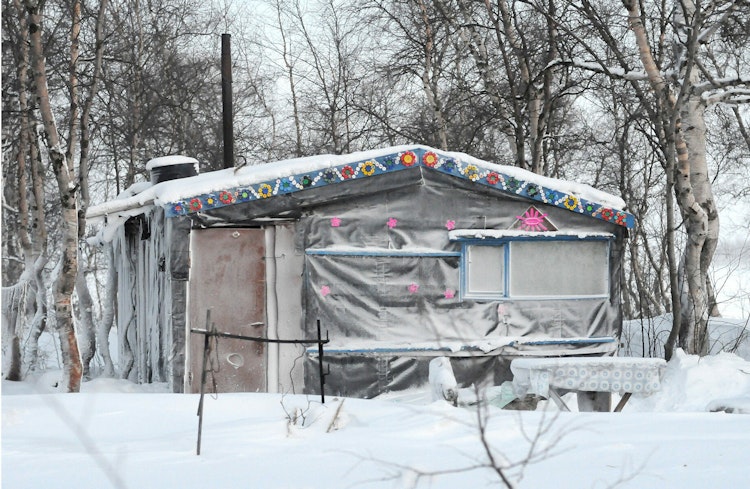
The photographs in your studio of architectural sites and these hand-knitted garments offer a different take on the tourist-focused souvenir or the t-shirt as gift. How are they connected for you?
'The sweaters are this sort of playful way of making new forms of representation from my culture. It goes for both the sweater project and the critical view on ethno-symbolism and architecture, but also on the Indigenuity Project and the way it is presented as images – as postcards.'
The Indigenuity Project has 52 images, the same as a deck of playing cards, yet another souvenir object connected to tourism. The work in the Indigenuity Project postcards shows how people transform natural and human-made objects and materials into physical design solutions. It’s a different way of thinking about material transformation and functionality – and about craft.
'I've been sort of looking at these real life examples of people that have done these on-site makeshift designs where they have shown an extreme capacity of improvising with the location, improvising with the limited resources, recycling ideas, or sort of being inventive and solving problems on-spot when the problem is occurring. I believe that autonomy and autonomous cultural dimensions are really created through adaptations. There's this tradition of adaptation that I think is at the core of the traditional and contemporary if you really start looking at what's being made in a vernacular Sámi setting. And this adaptation is what interests me but it's also really maybe one of the most important reasons for us having survived as we have done for thousands of years. We've been a minority up there for such a long time, and you can sometimes just be really amazed if you think about why we still wear this super different clothing and why we still have a completely different language. How have we been able to maintain it, you know? And I think that the capacity to adapt and to negotiate different roles when needed is really an important reason for it.'2


Broadly speaking, craft is often framed as the transformation of natural materials at the hand of a craftsperson that results in a functional object. Even with more conceptual craft, the maker relies on audience connection to materials, process, or forms associated with craft histories. But there is a shift in what constitutes materials for making that comes through in your projects as well as your recent work in Documenta. Natural materials used by indigenous communities are becoming increasingly endangered or hard to find, such as yellow cedar in Alaska or river cane in North Carolina. The Indian Arts and Crafts Board in the US, for example, is a government agency established in 1935 that promotes economic development through an arts and crafts market and, in some ways, still defines what is authentically indigenous based on these natural materials. And now, when the materials used by many tribes are increasingly unavailable, who decides what is or is not authentic indigenous craft? To force a group to only produce in a certain way or to only understand what is made as specific objects is problematic.
'I really agree so much. You see this all over the world as you’re pointing out, and, of course, it’s similar kind of constructions that are troubling us back home in Sápmi. I’m very, very interested in material flows. That is something that has been extremely important for the development of duodji and Sámi handicraft – material flow and access to material, transformation of material, and the sort of output, you could say, of the craft process. And it's a flow, you know? I think that it's very interesting to keep in mind the deep philosophy of duodji which is really a local material flow cycle. I think it's interesting to maintain that philosophical concept that you find in duodji but rethink it in a more contemporary scale. The world of material that is in my immediate surrounding is very different now than it was 200 years ago, for example, leftover materials or garbage. That's what I've been working with lately. In the project I did for Documenta, the European Everything project, everything I made was basically made at a metal recycling station where I had my studio. I was just sort of shocked being and interfering with this little business in the middle of Athens where they were buying and selling and trading material and basically being this important part of the machinery of the material flow stage in the flow cycle.'
There's something very interesting to me in the way that you are pushing against sort of historical fixity in terms of what constitutes craft materials and process or flow.
'Material flow in the contemporary or historical sense is maybe where my critical perspective towards duodji starts. It's a little bit of this feeling of duodji being somehow very much focused towards a historical use in relation to material. The way we used to go about our surroundings and our materials. It has become something that is not necessarily economically sustainable to spend two weeks to go into the woods, outsourcing the right material then driving it back to your studio. There's a lot of inefficiency in relation to the initial concept of how it started. It has become very complicated, and it doesn't stay true to the initial material flow cycle that duodji came out of. And I think that that is something that is very interesting to try and rethink in a contemporary sense. To, you know, take whatever is at hand around you and work with that to build, design, construct – whatever your sort of motivation is.'
A big and related aspect to the flow of material is also the flow of people
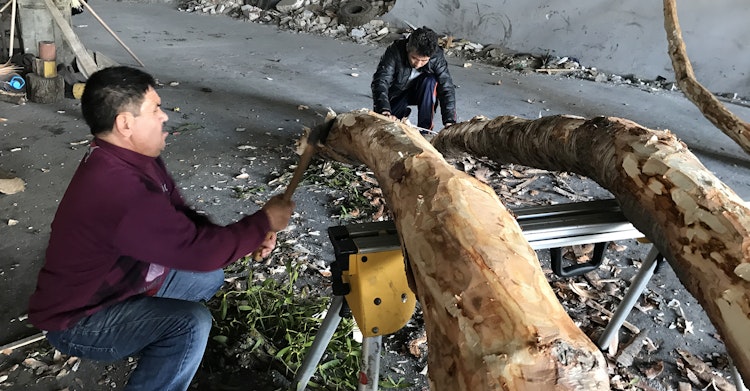
In terms of flow and cycles, you mentioned the ability to find something like a couch, or a rug, or things you need in a free system of discard and reuse that happens in Tromsø and Berlin, but that Athens was different because people were charging money for things that you would find for free in other cycles. It seems important for us to address the question of need and the economics connected to the displacement of people. In Athens there is an enormous refugee population whose hierarchy of basic needs is different – discard has a different value if you have nothing at all. If you did the same project in Tromsø, it would not mean the same thing. I wonder if you might touch on that a bit?
'A big and related aspect to the flow of material is also the flow of people. Having done a project for more than half a year while living in Athens and working in what definitely wouldn't be tourist part of Athens but more the more sort of challenged suburban area and sort of industrial slums surrounding Athens has, of course, confronted me with a lot of these kinds of flows. It was a really extreme social experience for me and confronted me a bit with the situation of privilege which I come from as a Norwegian but still a European, and still pretty much a part of the same system. So those things are definitely there, but they're also, for me as an artist, a little bit hard to approach in a way. I think my mandate as an artist and as a designer, an architect, has not been to directly approach them but to rather try and somehow include them in my work with the material flow. I find artworks that are conceptually framed as social a bit moralistic in their attempt to make the world into a better place. I find that a bit vulnerable in a way because it somehow manifests the social hierarchy and the privileged position of the artist or the designer sort of looking downwards at the troubled situation. I think it's much more interesting for me as an artist or designer to induce myself into the reality of lives or cultural groups, and just meet through the means of design or creating something – which is what I know, and which is what I can do, and which is what I’m interested in. I want to meet other people that are interested in it.'
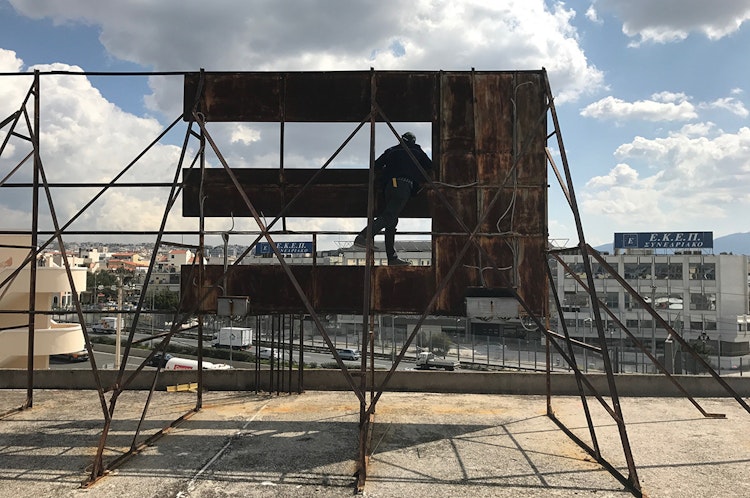
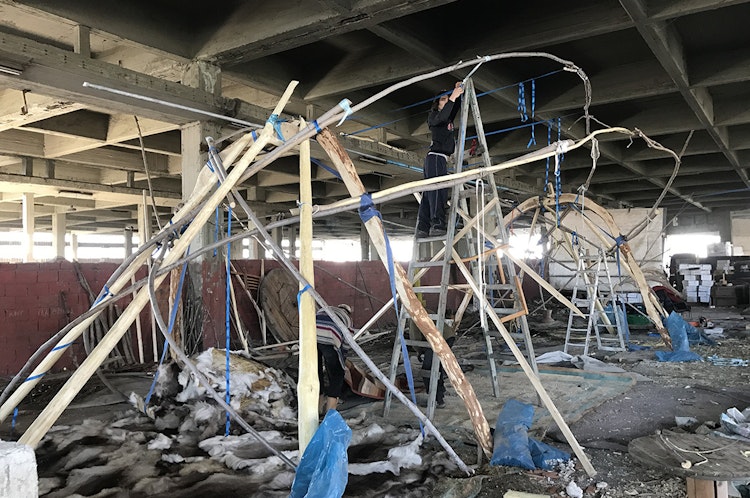
Who did you meet and what happened?
'Athens is filled with refugees. The biggest refugee camp in central Athens actually neighbors this metal recycling station that I was working at. People hang around. They have nothing to do. They're not even allowed to take jobs. They were basically, for days, standing by the fence, smoking cigarettes, watching me craft these wooden elements. I was working with an axe and and traditional Sámi construction elements called the bealljit. While I was working there with my axe they were, of course, trying to ask questions and then I just invited them over the fence to come help me. This turned out to be a very, very interesting meeting. I wouldn't say that they were working for me, but for that afternoon they helped and they came back a couple days later and started working. And I think they were just, in general, interested in what I was doing and why I was doing it, and they were interested in my tools. I showed them my axes and showed them how to use them. They were both from Afghanistan, and it was very apparent that one of them had used an axe before and the other one had not at all. It happened very organically. I wasn't actually trying very hard to sort of address their social marginalized situation, but I was very open to inviting them into my production when the situation felt right. And that's a little bit how I've been working as an artist lately with these kinds of questions. You know, it doesn't really matter where they come from. But, in the end, maybe where they come from can be a place, a fruitful contribution to what I'm doing. It became so, in this case, because just being in that trash, that recycling station and scrap dealer had an especially large flow of people that came through there selling their articles, remains after someone passed away or stolen copper wires. Just a lot of people that came through with material and connections in the building of the project with me just being there and meeting them.'
This bring to mind other questions of movement and the polarity of urban life versus nomadism or migratory aspects of Sami culture. I’d like to understand how you think about the forced migration that you saw in Athens versus the limitations that states or that national boundaries put on letting people move in a more «nomadic» way.
'This is really interesting, and I would love to think more about this down this line of thought because it's very complex, and I'm very much in the middle of this still after that Athens project especially. But I think it's important to understand them as separate systems. I think it's a bit dangerous to somehow put one up against the other. And thinking about such a word as, for example, nomadism, as I've been using quite a lot in my practice, it's a very general kind of term or definition that can be implied for so many different contexts and situations. Look at how Deleuze and Guattari have been writing about nomadism, using it as some kind of a visual leitmotif or motive for explaining something politic and philosophically/politically about the world and how it's structured. And in one way it's very meaningful, but on the other hand, it's also very abstract. And that says something about the word «nomadism». You also see a lot of designers in schools that are maybe unknowingly channeling their design production through a very capitalistic way of producing and thinking about space. They're using the word «nomadism», in my point of view, in an extremely naive way of thinking about everything that's mobile and transportable. If that's nomadism, that's really strange for me.'
How is nomadism different from displacement for you?
'For me, nomadism is something that I connect much more to my personal cultural background. The reindeer herding sort of way is completely different. It's all about avoiding that sort of limitation that capitalist production systems put on in a way. It's much more about actually having nothing and getting a lot when you enter into a place. For example, you try to leave as much behind as possible. But then, again, I'm also really open for thinking nomadism as something very, very modern and maybe related to sort of a future lifestyle also, where we're getting more and more sort of disembodied in our lifestyles, leaving the physical world behind and we sit down and Skype, and everything is like super virtual. There's something about physical movement that is changing and shaping our lives, and maybe there's a new kind of nomadism in that as well. And, for me, I think that's a really cool thing or interesting potential in the word «nomadism», but I also feel like it's important to know how you use it to be a bit specific and have some kind of consciousness about the use of that term. You just mentioned the word «displacement». There's very different sort of cultural take on, let's say, being a nomad or nomadism as well. The Sámi culture and my roots in a nomadic culture is extremely tied and connected to land and place. But if you look at the nomads, sort of nomadic movement works in a year cycle. If you're a reindeer, you move through the same kind of lines in the landscape back and forth throughout the year and it gives you this very, very connectedness to a specific piece of land. But it's just a more sort of extended idea of home, for example, or the idea that the sort of territory you belong to is something that's more expanded. It's not so framed and it's not so cultivated.'
The Sámi culture and my roots in a nomadic culture is extremely tied and connected to land and place
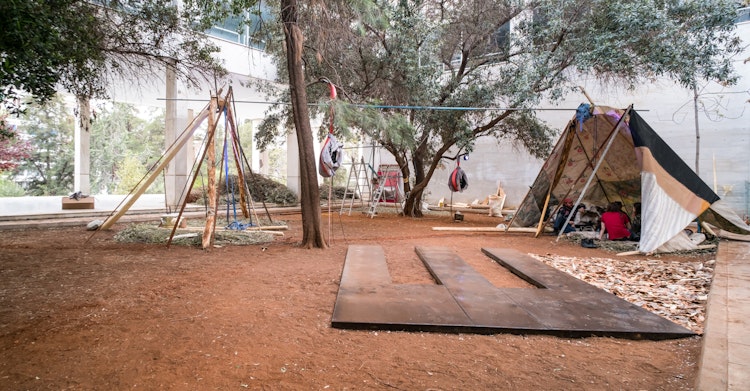
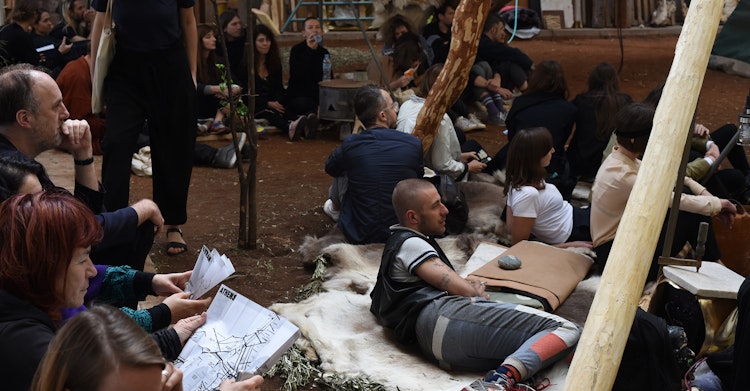
I was struck during my time in Norway by the range of types of craft. Your work disrupts and pushes against neat categorization.
'I'm interested in doing that, but I'm also at the same time interested in somehow not moving too much, too far away from the origins of craft and I feel like that's always a bit of a challenge, you know, to make sure you don't just become critical and to somehow be respectful or embracing of traditions and also communities. That's something I'm very concerned about – what kind of critical material or sort of framework we produce. We should really stay true to the origins in one way. And maybe that's also because then the critical sort of perspective can really reach the audience it should reach, right? But at the same time, it's really difficult to stay aligned with it. But I'm also a little bit afraid of doing it too much, in a way. Somehow, I find it sometimes a little bit too troublesome, you know. Especially contemporary art. Somehow, it's defining its own parameters and context so much that it's almost like it exists in a parallel dimension. It's easy to just shrug your shoulders. There's something there that I also find great about craft because somehow it has that very, very strong and pragmatic kind of connection to the past.'